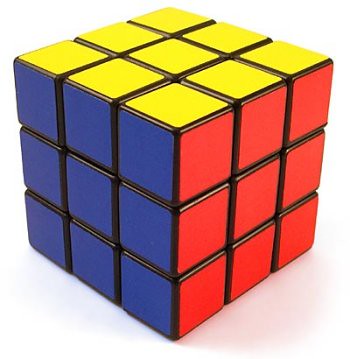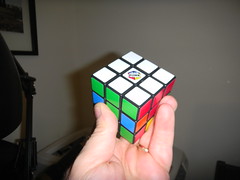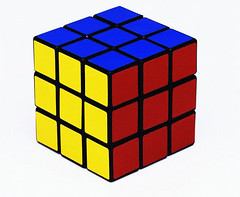This year mark’s the 30th anniversary of the Rubik’s Cube. I’ve seen and heard lots of references to it recently, and Office Depot has even started using it as one of their advertising logos.
All of this reminiscing brought back memories of my own experiences with the cube, and in particular, a piece of music that I composed based on the cube.
The year was 1981, and the cube was in its heyday. I was a music student at Furman University, and had been studying 20th Century composers and compositional techniques. I had also been spending just about every spare minute trying o solve the blasted cube.
One warm spring afternoon I was in a Furman Singers rehearsal, and we were working on “O Crux” by Knute Nystedt. This particular piece is very dissonant, and doesn’t resolve its intricate harmonies until the very end of the piece. I was drowsy from a late night of working on the cube, so as I semi-dozed through rehearsal, the strains of Nystedt blended with visions of Rubik’s Cube twirling, and a new musical composition popped into my brain.
Here’s how it works…
Aleatoric music is music based on chance. The term comes from the Latin alea, meaning “dice.” Instead of dice, my idea was to use the Rubik’s Cube as a tone generator. Each color and position would represent a tone on a scale. With the colors all mixed up, there would be total dissonance. As the cube was solved, the music would eventually resolve into a consonant harmony.
There are several ways this could be done. I first simplified things by solving for only one color, one side. In this scenario, the color for which you are solving becomes your tonic chord. So, for example, if we were solving for white and you wanted the piece in C-Major, then white would be a chord based on C as the tonic. Every other color is then assigned a different chord on that scale. For example, blue might be a chord based on the 2nd of the scale, red would be based on the 3rd, and so on. Each color represents a different 1-3-5 chord, some major, some minor depending on the starting point on the scale.
These chord/color combinations are assigned arbitrarily, although with work one could determine which combination would result in the most interesting harmonies. For example, if solving for white, then the opposite color, yellow, might be assigned to a chord based on the 5th of the scale. Blue might be based on the 2nd, and it’s opposite color, green, based on a 5th up from that, or the 6th of the tonic scale. Red might be based on the 3rd, and its opposite, orange would be based on a 5th up from that, or the 7th of the scale. All chords except the sub-dominant, or 4th, would be covered.
The position of the square would determine which of the chord’s tones – 1, 3, or 5 – was used. Since the middle square never changes, that row would be the root of the chord. The third of the chord would be the bottom row, and the fifth would be the top row, as shown below:
Each column could also represent a different octave. Since the middle square is static, it would be best to start there then work outward. The middle column would be a lower octave, the left column one up from that, and the right octave two up.
Using the scenario described above with color/chord assignments, starting on a C Major scale a mixed up cube might be assigned notes something like this:
As you solve the cube for one side, you would record each color and position, then translate that into the corresponding note. When you get done, you should have a C Major chord. The middle square will remain a C in the first octave throughout the piece, acting as a pedal point.
The chord above would sound a bit weird by itself. Also, subsequent chords would sound just as uninteresting. I think the best method would be to use these notes as the basis for a motif with some added rhythmic variant. As the cube is solved and the colors change, the notes available for the motif would also change. This gives the composer some flexibility as to style.
By this time you’ve either fallen asleep, or you’re wondering, “Where can I hear this music?” If the latter, then you’re just going to have to wait. It’s not ready – yet. I only got as far as the chordal framework, and never really finished the piece. The little bit I recorded back then was interesting from a theoretical standpoint, but flat-out boring to listen to.
Also, unfortunately, I’ve lost my original notebook, which means I have to start over from scratch. I bought a new cube, but after 30 years I had forgotten how to solve it, which means I’m starting from scratch there, too. There are several websites to help, but I would like to do this on my own. I’ve gotten so that I can solve for one color, but not for the whole thing, yet. So, I’m far enough along so that the music described here can be written.
Once the music is written and recorded, I’d like to create a video with the changing colors as the notes change. Since there are 43 billion possible combinations, the photos have to be taken as I’m writing down the notes, otherwise I’ll never be able to get it to match up. That’s going to be a long process.
I’m also working on ways of using the entire cube rather than just one color. I’m thinking of solving for three colors, as if looking at a corner view.
Probably the only way to make this work would be to have the middle colors represent the root, 3rd, and 5th of the tonic chord. That means the whole tonic chord would be present throughout the piece, rather than a single pedal point. The other colors would represent other scale tones, such as the 2nd, fourth, and sixth. All that would be missing would be the 7th tone. Positions would be irrelevant, unless you let certain rows/columns stand for octaves.
Regardless, it will be interesting to see how this all plays out. Once I get more comfortable solving for a single color, I’m going to start photographing the cube using my lightbox. Once I have the basic chord structure, I’ll write and record the piece and put it to video. We’ll see what happens. In the meantime, enjoy this little bit from visual artist VJFader, who has done something similar, but not exactly the same as what I proposed…
Projection Mapping Music Sequencer – Rubik’s Cube from VJFader on Vimeo.



